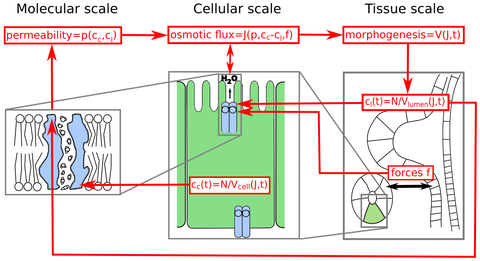DYNAFLOW
As part of the ERA-Net ERACoSysMed, the DYNAFLOW collaborative project is applying systems medicine approaches to studying and modeling of bile flow in the human liver. Disease conditions such as inflammation of the bile duct between the liver and the gall bladder, that may impair bile discharge, can aggravate so much that organ transplantation becomes necessary. Current pharmacotherapies fail to restore bile drainage partly because the multifarious coupling between flow, fluid pressure and bile production in the liver is still not understood.
At the ZIH we develop and simulate biophysical bile flow models. These models serve as a starting point for new therapeutic approaches to be designed in close cooperation with clinical partners. Red arrows in the figure indicate the regulatory feedback loops between relevant biophysical components of the bile secretion process. With our spatially-resolved models, we study the stabilizing and destabilizing effects of these feedback loops on bile secretion.
Partners
- Max Planck Institute of Molecular Cell Biology and Genetics
- Universitätsklinikum Carl Gustav Carus Dresden
- Oslo University Hospital
- Medical University of Vienna
- Technion Haifa
- Aix-Marseille Université
ZIH Contact
Duration
05/2016 - 04/2019
Funding
BMBF (031L0082A), European Commission /Horizon 2020
Publications
- O. Chara, L. Brusch. Mathematical modelling of fluid transport and its regulation at multiple scales. BioSystems 130, 1-10, 2015.
- K. Meyer, O. Ostrenko, G. Bourantas, H. Morales-Navarrete, N. Porat-Shliom, F. Segovia-Miranda, H. Nonaka, A. Ghaemi, J.-M. Verbavatz, L. Brusch, I. Sbalzarini, Y. Kalaidzidis, R. Weigert, M. Zerial.A predictive 3D multi-scale model of biliary fluid dynamics in the liver lobule.Cell Systems4,277,2017.

